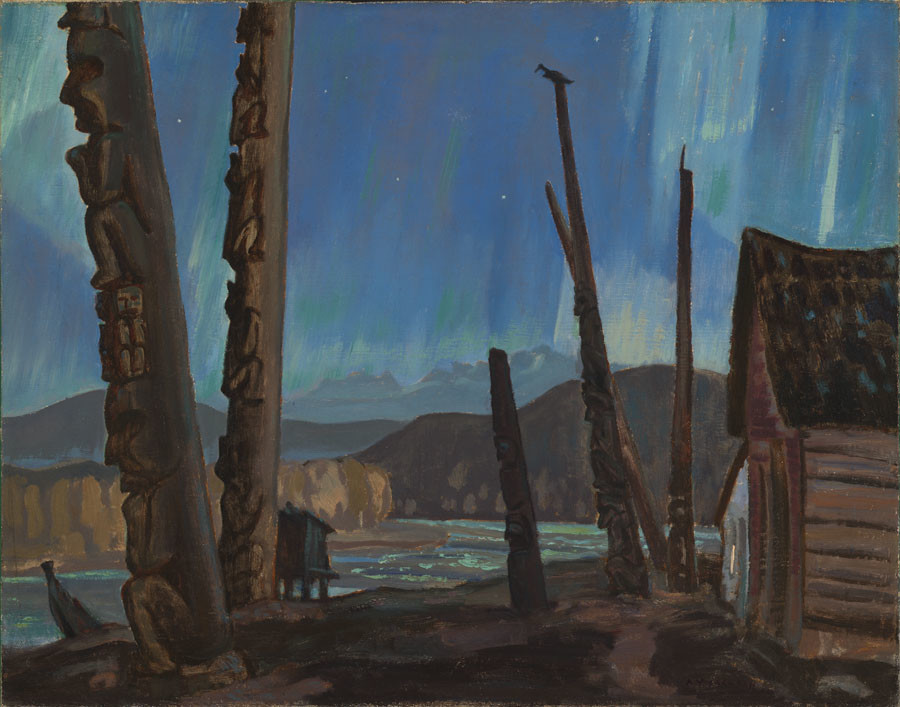A.Y. Jackson's Skeena River Canvases
 A.Y. Jackson | Night on the Skeena River", 1927 | Oil on canvas 25 x 32 ins.
A.Y. Jackson | Night on the Skeena River", 1927 | Oil on canvas 25 x 32 ins.
Continued discussion regarding our discovery of the important canvas by A.Y. Jackson, "Night on the Skeena River", 1927, has prompted me to write a few additional comments. Prior the re-emergence of "Night on the Skeena River", 1927, the available evidence led us to believe that Jackson had "worked up" six canvases from the sketches he had painted during his trip to the Skeena River in 1926, and a seventh canvas at a later date. Excluding the later canvas, the figure six was a composite, using titles taken from the various exhibition records of the period, as well as a letter written by A.Y. Jackson to ethnographer Marius Barbeau in June of 1933, a letter in which Jackson listed those works that he considered his most important along with their current owners. At the time we acquired "Night on the Skeena River", 1927, only four of the known Skeena River canvases had been seen by contemporary researchers:
- "Kispayaks Village" (Art Gallery of Greater Victoria)
- "Skeena Crossing" (McMichael Canadian Art Collection)
- "Indian House, Port Essington, B.C."
- "Totems, Hazelton, B.C." (this was known from records and an old photograph of the 1927 exhibition Canadian West Coast Art, Native and Modern at the National Gallery of Canada, a copy of which can be found in Dr. Charles C. Hill's book "Emily Carr".)
Unknown were the whereabouts of the paintings by two other titles:
- "Dusk at Usk"
- "Night on the Skeena River" (this title appeared in A.Y. Jackson's 1933 letter to Marius Barbeau but no image of the painting was known.)

A.Y. Jackson (1882-1974) | Hazelton, B.C. 1926 | Drawing 21.3 x 27.6 cm | Property of the National Gallery of Canada (nº 17470r) | Purchased in 1973 | Courtesy of the Estate of the late Dr. Naomi Jackson Groves
When we acquired the painting known as "Night on the Skeena River", three indicators led us to conclude that it was the same painting known to researchers as "Totems, Hazelton, B.C.". First, "Night on the Skeena River" has a direct relationship to the drawing A.Y. Jackson had titled "Totems, Hazelton, B.C." (National Gallery of Canada). Additionally, the work had been acquired from the descendants of the original purchaser identified by Jackson as the owner of "Night on the Skeena River" in his 1933 letter to Marius Barbeau. Finally, and most definitively, Dr. Charles Hill's book "Emily Carr", contains a black and white photograph of the National Museum of Canada's (today National Gallery of Canada) 1927 exhibition Canadian West Coast Art, Native and Modern in which this painting can clearly be seen hanging but which the records from the exhibition refer to as "Totems, Hazelton, B.C". The latter was first brought to our attention by an astute client.

A reproduction of the photo from the 1927 exhibition "Canadian West Coast Art, Native and Modern" When the painting arrived at the gallery from the United States, it was the first time in 80 years that the art world had the opportunity to see the work we knew only by Jackson's 1933 title, "Night on the Skeena River", and cross reference it with the drawing in the National Gallery and the painting found in the image from the 1927 exhibition, both titled "Totems, Hazelton B.C.". Relying on this evidence and also in part on our first hand experience with the artist, we can suggest that sometime between its original showing in the 1927 exhibition Canadian West Coast Art, Native and Modern and its sale in or before 1933, Jackson changed the title from a documentary one to a more poetic one. We were therefore able to whittle down the number of known canvases painted shortly after Jackson's return from the Skeena River to five.
Of those, "Night on the Skeena River", 1927 is one of only two that are not in permanent museum collections, that is if the other one, "Dusk at Usk", still exists. The present location of "Night on the Skeena River" can be recorded as "Private collection". Throughout our research, we were in consultation with distinguished curator Joan Murray, who is a leading expert on the Group of Seven and author of the Tom Thomson Catalogue raisonné. Murray also did a great deal of research and penned a marvelous essay about "Night on the Skeena River", which we encourage you to read. Further valuable information was provided by Dr. Hill, who is the senior Curator of Canadian Art at the National Gallery of Canada and author of the book "Emily Carr" in which the photograph of the West Coast Art exhibition appears.






